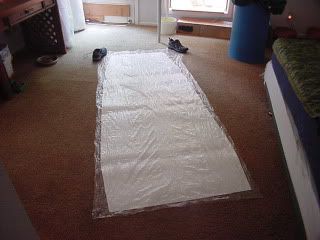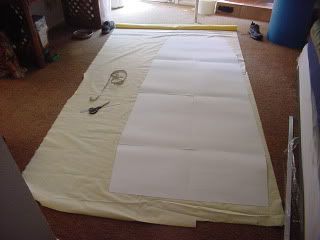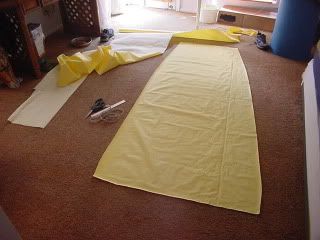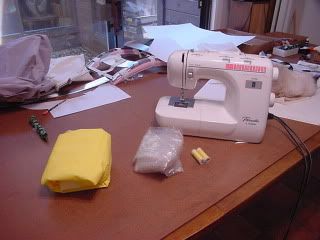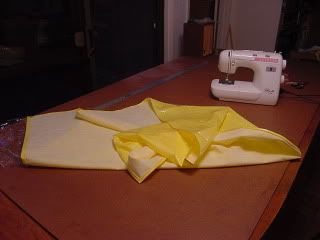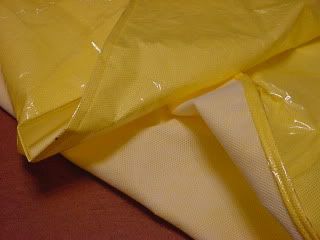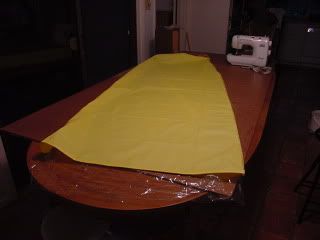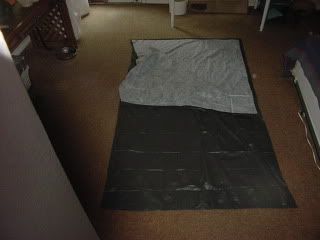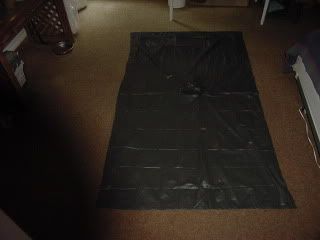Topic
GG Polycryo / Propore Bivy
Forum Posting
A Membership is required to post in the forums. Login or become a member to post in the member forums!
Home › Forums › Gear Forums › Make Your Own Gear › GG Polycryo / Propore Bivy
- This topic is empty.
-
AuthorPosts
-
Jun 17, 2009 at 10:30 am #1237142
To make it easier to find the part of this thread about the GG Polycryo / Propore Bivy I decided to give this project its own Thread.
Super Ultra Light / Super Ultra Cheap PT 1 – Making the Bivy:
The first picture shows the GG Ground Cloth laying on my pattern. The size of the Ground Cloth is almost the same size as my pattern. I am leaving a 1" seam allowance. This will allow me to turn it under to reinforce the seam.
1. GG Ground Cloth on the Pattern.

2. The GG Ground Cloth is cut and weighs 41 grams or 1.44 ounces. Cost for one of 2 GG Ground Cloths = $4.00 plus shipping.

3. The Propore on the Pattern ready to mark.

4. The Propore cut and ready to sew. The weight of the Propore Bivy Top is 4.7 ounces. Cost as a new Frogg Toggs Poncho = $11.50 plus shipping. I have 2 Frogg Toggs Ponchos on order and when I get them I will make another Bivy out of one of them.

5. Ready to start sewing.

Estimated cost for the materials only for the completed Bivy = $17.00 (+/-) a bit.
Estimated weight of the completed Bivy = 6 ounces (+/-) a bitSewing to follow.
NOTICE!!!!!!!!!
I had a lot of problems finding a way to sew the Polycryo material.
I would suggest anyone that wants to sew with this material that you do many tests and stress the seams a bit till you are happy with the sewing method.
6.

7.

8.

The Bivy weighs 6.1 ounces. I will make a small hood out of Propore and attach the hood sometime over the next day or so.
A "Waterproof / Breathable Bivy" like this can be made for about $17.00.
===========
Instant Bivy:
I received the two Frogg Toggs Ponchos this evening from Sierra Trading Post. Three and a half days after I ordered them. Quick shipping.
The Poncho is 52" wide by 87" long. The Poncho has three snaps on each side to close the Poncho when you are wearing it. The Poncho weighs 238 grams / 8.4 ounces.
The first thing I wanted to try was snapping both Ponchos together to make an "Instant Bivy".
I got in between the two snapped together Ponchos. My room was 76 degrees "F" and I think I started to get warm in the "Instant Bivy".
The cost for a Bivy like this would be $24.00 for the two Ponchos.
The weight for two Ponchos used as a Bivy would be about 16.8 ounces. This would figure out to $1.45 per ounce.I think a Bivy made from two Frogg Toggs Ponchos would make a good multi use piece of gear. A Poncho when needed and your Bivy at night.
The Frogg Toggs DriDucks material maybe as good or better than eVent and it sure cost a lot less.
1. Both Frogg Toggs Ponchos snapped together.

2. Frogg Toggs Poncho open halfway.

==
The Frogg Toggs – DriDuck material is really nice. It is to bad we can't buy it by the yard. But since we can't buy eVent we can buy the Poncho and use the material from it. As best I can figure the DriDucks material from a Frogg Toggs Poncho cost $2.86 a sq yard.
Going back to my first idea for this material, when used with the Gossamer Gear Polycryo Ground Cloth it will make a Bivy that would weigh a bit less then 10 ounces and a cost of $13 plus shipping.
Jun 17, 2009 at 10:40 am #1508814I received two "Two-Packs" of GG Polycryo Ground Sheets in the mail today.
I am working out a design to use one of thePolycryo Ground Sheets with one of my Frogg Troggs Poncho's and make another Bivy.
Jun 17, 2009 at 12:10 pm #1508835Bill, that's pretty slick. $17 and barely over 6 ounces is awesome. Any plans of taking it out in the field?
Jun 17, 2009 at 2:32 pm #1508867Bill,
Recieved some polycryo today as well based on this exact thread. I'm planning to use a momentum top but still "fairly" cheap and high'ish performance.
Question for you. I've read where you stated the polycryo is tough to sew. Curious what you ended coming up with for seaming the two materials together?
Starting work on mine tonight : ) Can't wait!
Thanks,
EricJun 17, 2009 at 3:06 pm #1508878Is the dryducks material different from:
Tyvek WT/SQ YD=1.25 oz Spunbonded olefin. Style 1443R ???
at http://questoutfitters.com/ $4.99/yard 60" wideJun 17, 2009 at 3:43 pm #1508890Hi Eric,
Eric: "Question for you. I've read where you stated the polycryo is tough to sew. Curious what you ended coming up with for seaming the two materials together?"
======
With some scrap:
Try a few different stitch lengths and stitch widths and then pull on the seam a "Little" and see what happens. My machine settings were in the 2.5 to 3 range but yours could be different.
I then laid the Polycryo on the Propore and folded it two times for a seam width of about 3/4 inch. You can try less seam allowance if you want but that is easy for me. I used a small zig-zag stitch. What I am trying to do is keep any stress on the Propore and not on the Polycryo. I also use pinch type cloths pins to hold the material as I sew it. I don't get any extra holes in the material that way.
Then just take your time, keep the extra material from getting caught under the needle and getting sewn into your stitch line. I sew on a large table so I can keep the extra material well organized. I have learned the hard way and have had to rip-stitch a time or two. Now I spread out and keep the extra material out of the way.
Good Luck but you should do fine.
Jun 17, 2009 at 3:50 pm #1508892Hi Walter,
DiDucks material is owned and made by Frogg Toggs and is not the same as Tyvek.
I have never used Tyvek so I can not say how alike the two might be.
I went with Frogg Toggs from user reports about how well the material worked.
If I could buy Propore I would stay with it but Propore is out of production.
Jun 17, 2009 at 4:01 pm #1508895Steven,
I have used this Bivy several times on the grass in my backyard "Wilderness".
My part of Texas is hot (over 100 degrees F for the high) most days now that we are well into summer. The overnight lows are mid-to high 70's so the Bivy is a bit over kill. Last night about 10 PM it was still 90 F.
I have used the Bivy on my bed at night (with my AC on) at a much lower temp and the Bivy was very nice without anything other than shorts and a t-shirt on.
Jun 17, 2009 at 5:24 pm #1508910Bill,
Much appreciation for your insight. I spent a considerable amount of time getting a sewing method down for sewing my spinntex tarp. Took a bit to get it all situated but getting better.
I like the idea of extra seam allowance tied into the construction. Easier to handle and sew.
Would you seam seal the seam after sewing (internal)? having not done a bivy yet, trying to get my detials squared away.
Thanks again for spurring on the idea. Hoping I can fabricate something useful from your guide…
Thanks,
EricJun 17, 2009 at 6:40 pm #1508928Hi Eric,
Seam Sealing is more of a personnel choice. Some swear by it but I usually just make a mess out of it.
I like to use a Hammock so I am not really on the ground that much. If sleep a lot on the ground and you hike where it rains a lot it might be worth the effort. You might ask if I use my Bivy in my Hammock, yes I do. You just need to practice wiggling into it a few times to learn how to get in and out of it while in the Hammock. The Hammock is one of the reasons I make the Bivy opening a bit wider.
Jun 17, 2009 at 11:40 pm #1508969Bill:
I really like your simply bivy design. No zippers, mesh, etc.
What about making a similar bivy using basic 1.1 oz dwr ripstop and 1.3 oz silnylon? The bivy would not have a WPB top if you replace the Propore with DWR ripstop but most bivy's around here are not WPB anyway.
You could buy 2 yards of ripstop 2nds and 2 yards of silnylon 2nds for about $24 + shipping. You could cut the fabric into two 36×60 rectangles to get the desired length. With seem allowances that would give you a 70 inch girth which should be enough for small to average sized folks. The only downside would be that you would have to sew an extra seem across the center of the bivy.
When you consider that the polycro and propore will be coming from separate vendors and that the silnylon and ripstop can be purchased together from OWF, Quest, or thru-hiker these two projects would have about the same cost after you factor in shipping.
I know the ripstop and silnylon could create a 6 oz +/- bivy.
So, I guess I don't really understand why the Polycro/Propore bivy would be any more SUL or SUC than the standard dwr ripstop/silnylon bivy.
If the ripstop/silnylon bivy is just as light, just as cheap, easier to sew (you mentioned the polycro was difficult to sew) and probably more durable, what is the advantage of the polycro/propore bivy?
Jun 18, 2009 at 12:22 am #1508976Hi Scott,
Thanks for taking the time to post such a good comment. However, to answer your question you need to go back to the "Parent Thread" for this topic.
Super Ultra Light / Super Ultra Cheap
The "Standard" for this project is to create a WPB Bivy as good as one of the eVent ones that cost $200 plus but at a much lower cost. The top shell material has to be WPB.
Propore or the Frogg Toggs Poncho material is WPB so it is used for the top shell material and the Polycryo is waterproof for the bottom material. This combination meets the WPB requirement and does it at a very low price.
Your idea is a good one and would give you a nice Bivy at a very low cost if being waterproof is not a problem for you.
Jun 18, 2009 at 8:49 am #1509028Bill,
Few more for you. Curious if you sewed this inside out or not? So double hem rolled in towards the Polycryo (Poly on top)?
Trying to get a handle on sewing this stuff. The Polycryo is tough stuff as a sheet but once perforated, it gets a little fragile. Need to work on it again tonight some.
Thanks again.
EricJun 21, 2009 at 1:41 pm #1509626Just a thought on the propore-I have seen propore car covers for ~$60. Lots of fabric in one of those, though there are some seams on them. Should be good for 3-4 bivy tops,
Jun 21, 2009 at 4:58 pm #1509645Hi Eric,
I have used my Bivy a few times and it doesn't seem to be holding up very well.
I had not noticed a tear toward the foot end until I just turned it inside out to look at the fold. When I sewed it I folded the Polycryo over the Propore. I just tore it apart. That was way to easy. Now to rip the thread out of the Propore.
You might want to test a few different seam methods and see if you have better luck.
I have two more packs of ground cloths and might try another one with the Propore folded over the Polycryo but not now. I am going to let this idea sit awhile and play with my two Frogg Toggs Poncho's. The Bivy cost goes up to about $20. Still not bad for a WPB Bivy.
Failure is not failure if you learn something from it.
Jun 21, 2009 at 6:42 pm #1509656Bill,
I've seen similar issues here with just mocking up my seams. Looks like the perforations cause some issues with tearing along the seam.
I'm wondering/thinking I might be able to seam tape the polycryo where I'm going to run the seam and it might increase the strength enough to make this viable.
Depending on what tape works well, might be a low cost/minimal weight addition.
Jun 21, 2009 at 9:00 pm #1509675Eric,
I tried some tape that works on Cuben but it tore next to the tape line.I tried it twice and it tore both times.
All this doesn't have to mean it will not work. It may just need more testing to figure it out.
Jun 22, 2009 at 6:42 am #1509693It has been suggested that heat shrink window insulation is the same as polycryo. The 2 sided tape that comes with it is cheap, light and stronger than the insulation film. Taping two pieces of the film together, the film breaks not the taped connection. I don't know if it sticks to the Frogg Togg material. Just one more possibility to play with.
-
AuthorPosts
- You must be logged in to reply to this topic.
Forum Posting
A Membership is required to post in the forums. Login or become a member to post in the member forums!
Our Community Posts are Moderated
Backpacking Light community posts are moderated and here to foster helpful and positive discussions about lightweight backpacking. Please be mindful of our values and boundaries and review our Community Guidelines prior to posting.
Get the Newsletter
Gear Research & Discovery Tools
- Browse our curated Gear Shop
- See the latest Gear Deals and Sales
- Our Recommendations
- Search for Gear on Sale with the Gear Finder
- Used Gear Swap
- Member Gear Reviews and BPL Gear Review Articles
- Browse by Gear Type or Brand.

